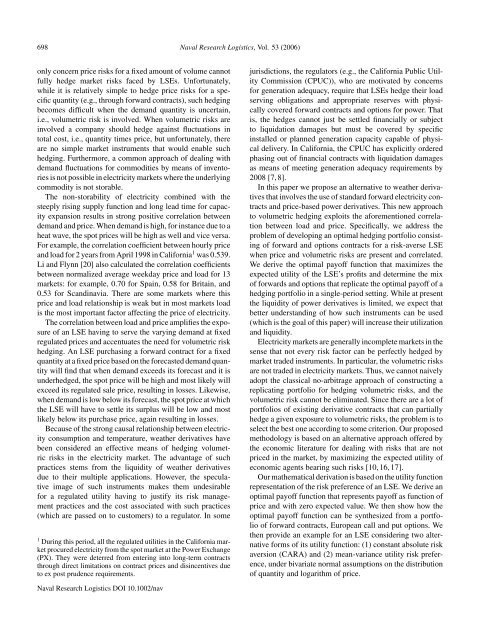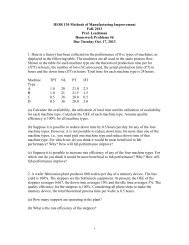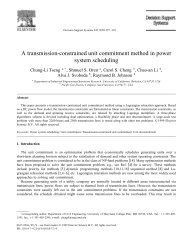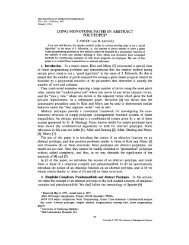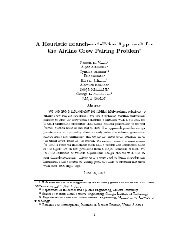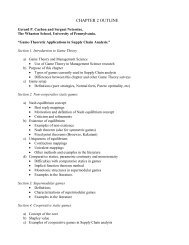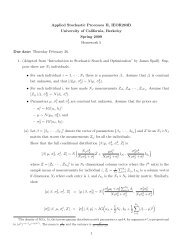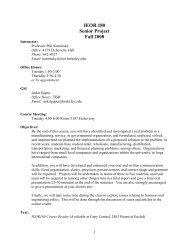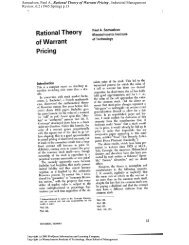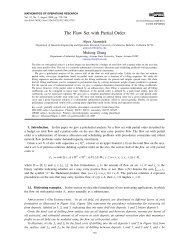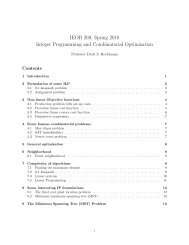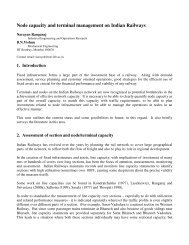Hedging Quantity Risks with Standard Power Options - UC Berkeley ...
Hedging Quantity Risks with Standard Power Options - UC Berkeley ...
Hedging Quantity Risks with Standard Power Options - UC Berkeley ...
You also want an ePaper? Increase the reach of your titles
YUMPU automatically turns print PDFs into web optimized ePapers that Google loves.
698 Naval Research Logistics, Vol. 53 (2006)<br />
only concern price risks for a fixed amount of volume cannot<br />
fully hedge market risks faced by LSEs. Unfortunately,<br />
while it is relatively simple to hedge price risks for a specific<br />
quantity (e.g., through forward contracts), such hedging<br />
becomes difficult when the demand quantity is uncertain,<br />
i.e., volumetric risk is involved. When volumetric risks are<br />
involved a company should hedge against fluctuations in<br />
total cost, i.e., quantity times price, but unfortunately, there<br />
are no simple market instruments that would enable such<br />
hedging. Furthermore, a common approach of dealing <strong>with</strong><br />
demand fluctuations for commodities by means of inventories<br />
is not possible in electricity markets where the underlying<br />
commodity is not storable.<br />
The non-storability of electricity combined <strong>with</strong> the<br />
steeply rising supply function and long lead time for capacity<br />
expansion results in strong positive correlation between<br />
demand and price. When demand is high, for instance due to a<br />
heat wave, the spot prices will be high as well and vice versa.<br />
For example, the correlation coefficient between hourly price<br />
and load for 2 years from April 1998 in California 1 was 0.539.<br />
Li and Flynn [20] also calculated the correlation coefficients<br />
between normalized average weekday price and load for 13<br />
markets: for example, 0.70 for Spain, 0.58 for Britain, and<br />
0.53 for Scandinavia. There are some markets where this<br />
price and load relationship is weak but in most markets load<br />
is the most important factor affecting the price of electricity.<br />
The correlation between load and price amplifies the exposure<br />
of an LSE having to serve the varying demand at fixed<br />
regulated prices and accentuates the need for volumetric risk<br />
hedging. An LSE purchasing a forward contract for a fixed<br />
quantity at a fixed price based on the forecasted demand quantity<br />
will find that when demand exceeds its forecast and it is<br />
underhedged, the spot price will be high and most likely will<br />
exceed its regulated sale price, resulting in losses. Likewise,<br />
when demand is low below its forecast, the spot price at which<br />
the LSE will have to settle its surplus will be low and most<br />
likely below its purchase price, again resulting in losses.<br />
Because of the strong causal relationship between electricity<br />
consumption and temperature, weather derivatives have<br />
been considered an effective means of hedging volumetric<br />
risks in the electricity market. The advantage of such<br />
practices stems from the liquidity of weather derivatives<br />
due to their multiple applications. However, the speculative<br />
image of such instruments makes them undesirable<br />
for a regulated utility having to justify its risk management<br />
practices and the cost associated <strong>with</strong> such practices<br />
(which are passed on to customers) to a regulator. In some<br />
1 During this period, all the regulated utilities in the California market<br />
procured electricity from the spot market at the <strong>Power</strong> Exchange<br />
(PX). They were deterred from entering into long-term contracts<br />
through direct limitations on contract prices and disincentives due<br />
to ex post prudence requirements.<br />
jurisdictions, the regulators (e.g., the California Public Utility<br />
Commission (CP<strong>UC</strong>)), who are motivated by concerns<br />
for generation adequacy, require that LSEs hedge their load<br />
serving obligations and appropriate reserves <strong>with</strong> physically<br />
covered forward contracts and options for power. That<br />
is, the hedges cannot just be settled financially or subject<br />
to liquidation damages but must be covered by specific<br />
installed or planned generation capacity capable of physical<br />
delivery. In California, the CP<strong>UC</strong> has explicitly ordered<br />
phasing out of financial contracts <strong>with</strong> liquidation damages<br />
as means of meeting generation adequacy requirements by<br />
2008 [7, 8].<br />
In this paper we propose an alternative to weather derivatives<br />
that involves the use of standard forward electricity contracts<br />
and price-based power derivatives. This new approach<br />
to volumetric hedging exploits the aforementioned correlation<br />
between load and price. Specifically, we address the<br />
problem of developing an optimal hedging portfolio consisting<br />
of forward and options contracts for a risk-averse LSE<br />
when price and volumetric risks are present and correlated.<br />
We derive the optimal payoff function that maximizes the<br />
expected utility of the LSE’s profits and determine the mix<br />
of forwards and options that replicate the optimal payoff of a<br />
hedging portfolio in a single-period setting. While at present<br />
the liquidity of power derivatives is limited, we expect that<br />
better understanding of how such instruments can be used<br />
(which is the goal of this paper) will increase their utilization<br />
and liquidity.<br />
Electricity markets are generally incomplete markets in the<br />
sense that not every risk factor can be perfectly hedged by<br />
market traded instruments. In particular, the volumetric risks<br />
are not traded in electricity markets. Thus, we cannot naively<br />
adopt the classical no-arbitrage approach of constructing a<br />
replicating portfolio for hedging volumetric risks, and the<br />
volumetric risk cannot be eliminated. Since there are a lot of<br />
portfolios of existing derivative contracts that can partially<br />
hedge a given exposure to volumetric risks, the problem is to<br />
select the best one according to some criterion. Our proposed<br />
methodology is based on an alternative approach offered by<br />
the economic literature for dealing <strong>with</strong> risks that are not<br />
priced in the market, by maximizing the expected utility of<br />
economic agents bearing such risks [10, 16, 17].<br />
Our mathematical derivation is based on the utility function<br />
representation of the risk preference of an LSE. We derive an<br />
optimal payoff function that represents payoff as function of<br />
price and <strong>with</strong> zero expected value. We then show how the<br />
optimal payoff function can be synthesized from a portfolio<br />
of forward contracts, European call and put options. We<br />
then provide an example for an LSE considering two alternative<br />
forms of its utility function: (1) constant absolute risk<br />
aversion (CARA) and (2) mean-variance utility risk preference,<br />
under bivariate normal assumptions on the distribution<br />
of quantity and logarithm of price.<br />
Naval Research Logistics DOI 10.1002/nav


